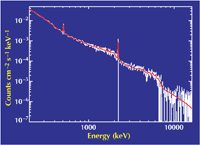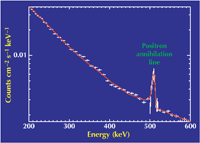RHESSI gamma-ray spectroscopy
The heart of the RHESSI observatory is its set of nine large high-purity germanium detectors. These can precisely determine the energies of photons in the range .03-15 MeV, spanning the hard X-rays and gamma rays. Especially in the latter range, astronomy is in its infancy because of the extraordinary difficulty of collimating, imaging, or even detecting gamma rays. RHESSI has been the first observatory in space with such an array of Ge detectors.Solar flares emit hard radiation, including gamma rays and "solar cosmic rays," as a result of nuclear and plasma-physics processes involved in these huge magnetic explosions. The gamma-ray spectra below both come from the flare of December 6, 2006:

|

|
| Left, a full spectrum of the flare in the MeV range, showing two bright lines and several other components. The cutoff at about 7 MeV is from solar nuclei that were excited in the impact of flare-associated protons. Right, a closeup of the 0.511-MeV line resulting from the annihliation of secondary positrons with electrons deep in the solar atmosphere. The formation of this strong line remains quite mysterious. Click for larger versions of the figures. |
The gamma radiation reflects the strong particle acceleration involved in solar flares, something that also occurs in major flare/CME events. This newly discovered pattern of occurrence presumably reflects processes deep in the solar interior, and this may provide us with a handle on "space weather" effects over solar-cycle time scales (decades). The process that accelerates particles on closed loops to produce the gamma rays does not necessarily reflect the most significan source of SEPs.